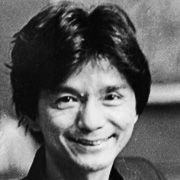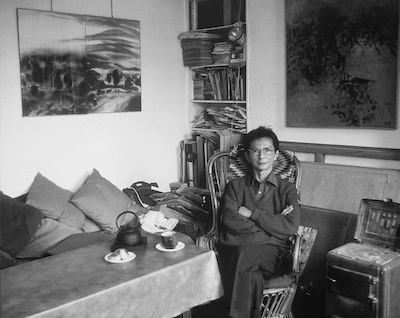
(1927-1991)
T’ang Haywen was a Chinese-born painter who lived and worked in Paris. He belongs to the second generation of Chinese artists who emigrated to France after the Second World War, which included Chu Teh-Chun and Zao Wou-Ki. Both calligraphy and the principles of Taoism played a role in shaping T’ang’s art.
Exhibitions
T’ang Haywen’s early life and artistic training
T’ang Haywen (born as Zeng Tianfu) was born in Xiamen in China’s Fujian Province on 20 December 1927. T’ang Haywen moved to the city now known as Ho Chi Minh City in Vietnam at the age of 10 years old.
Like his contemporaries, the painters Chu Teh-Chun and Zao Wou-Ki, T’ang Haywen travelled to France to pursue his ambition to train as an artist. In contrast to Chu Teh-Chun and Zao Wou-Ki, who studied at the Hangzhou Academy of Art (now the China Academy of Art), T’ang Haywen did not receive any formal artistic training. It was, rather, his knowledge and understanding of calligraphy and Taoism, instilled by his grandfather, that informed his intellectual and artistic development.
The Chinese painter T’ang Haywen in Paris
T’ang Haywen moved to France in 1948, ostensibly to study medicine in keeping with his family’s wishes. However, he abandoned his medical studies, taking classes at the Académie de la Grande Chaumière instead and studying the works of Gauguin, Cézanne and Matisse in the museums of Paris. In his early works, T’ang Haywen explored a variety of themes, including interior design, portraits, self-portraits, still lifes and views of Paris.
His fascination with Shi Tao—the 17th century individualist painter—greatly influenced his work. Writing to his brother in 1958, T’ang said: “I have found my vocation in painting… something I didn’t think would please our parents… it is a very serious matter, in which there can be no question, honestly, of seeking success for its own sake… In order to be genuine, success must be completely sincere. Once a painter has found himself, then and only then can he work for others, which he must do, but not before … I cannot and nor would I wish to abandon this vocation.”
T’ang Haywen’s inks
In the early 1960s, T’ang Haywen demonstrated a preference for ink on paper, gouache and watercolour. The painter defined an original and personal pictorial space using standard-sized sheets of cardboard. First working in 29.7 x 21 cm and 70 x 50 cm formats, he then went on double these formats to create diptychs. The 70 x 100 cm format is one of the most common formats in T’ang Haywen’s work.
The Chinese painter T’ang Haywen’s sources of inspiration
In 1964, T’ang Haywen painted his Hommage à Cézanne on a 70 x 50 cm sheet of paper. In the piece, he revisited the composition of Cézanne’s Bathers (Les Grandes Baigneuses).
During the period from 1960 to 1965, T’ang Haywen painted a series of very small oil paintings, most of which were created on a canvas of newsprint. While oil was the preferred medium of Western artists, T’ang Haywen’s use of newsprint revealed his modest living conditions as an artist.
In 1968, T’ang Haywen painted a large diptych of a group of three naked women with dark hair and skin, inspired by Gauguin. The piece was reminiscent of Gauguin’s greatest work: Where Do We Come From? What Are We? Where Are We Going? The Chinese painter inscribed the back of the piece with the words: “D’où venons-nous ?” [“Where do we come from?”]
T’ang Haywen & the cinema
In the early 1970s, T’ang Haywen was invited to India to visit Goa by the Maharani of Porbandar. On the beach in Goa, he made the acquaintance of the filmmaker Tom Tam and his partner Martha Sandler. T’ang Haywen appeared with Martha in the psychedelic short film Furen Boogie. In 1973, Tom Tam and T’ang Haywen shot T’ang Boogie—probably the first art film by a modern Chinese artist—in his little Parisian apartment on Rue Liancourt.
The Chinese painter T’ang Haywen’s exhibitions around the world
In the 1970s and 1980s, T’ang Haywen continued to travel, his trips and exhibitions advancing hand in hand. In 1975, the curator Mary Tregear presented T’ang Haywen’s ink paintings at the Ashmolean Museum in Oxford. His works were also exhibited on several occasions at Nane Stern’s gallery in Paris and other galleries in Switzerland, Italy and Germany. On the recommendation of a friend, T’ang Haywen met the renowned collector Dominique de Ménil in the United States, who acquired one of his diptychs.
Chinese painting and calligraphy use the same materials: round brushes on paper or silk, with ink and water. Although some consider the works of these genres abstract by nature, the Chinese artists Zao Wou KI, Chu Teh Chun and T’ang Haywen never thought of themselves as abstract painters. In 1972, T’ang Haywen wrote: “There is no doubt that the play of abstraction can briefly inspire people’s thoughts in an instant, but when it comes to deciphering and understanding the past, there is no further flourishing of sensibility, numbers are dead and even memories disappear. Our profound sensibility, related to the unconscious, can only develop and grow when nourished by the tangible, that is to say, as far as painting is concerned, by the recollection in our conscious memory of profound and lasting sensitive experiences that we have had in the real world. It is on the basis of a certain, and more or less preponderant, material figurative representation that painting can develop and renew itself without losing itself, and expand into the realms of emotion and spirituality…”
At the beginning of the 1980s, T’ang Haywen continued to produce diptychs in a variety of formats, also creating small triptychs in ink and colour and numerous small watercolours. Living more simply, his spiritual journey brought him closer to a group of friends, including the gallery owner Nane Stern. It was during this period that T’ang Haywen travelled to Fontgombault Abbey. He then converted to Catholicism and was baptised in 1984 and given the Christian name François, which means “free man”.
In 1983 and 1984, thanks to his friend Dominique Ponnau, T’ang Haywen exhibited at the Musée des Beaux-Arts de Quimper in Brittany and then at the Musée du Château de Vitré. His large diptychs were painted on sheets of cardboard produced from wood fibres. With some of his friends encouraging him to choose a more refined medium, T’ang Haywen began to paint on Arches paper—produced from cotton fibres and known for its durability.
T’ang Haywen continued to travel, exhibiting his paintings in France and abroad. His last major trip took him to Georgia, but his health was deteriorating. Suffering from AIDS, T’ang Haywen died in Paris on 9 September 1991.
Posthumous recognition of the Chinese painter T’ang Haywen
Towards the end of the 1990s, T’ang Haywen’s work began to draw the attention of much wider audiences. Several important exhibitions—in particular those at the Oceanographic Museum in Monaco, the Taipei Fine Arts Museum in Taiwan, the Musée Guimet in Paris and the Shiseido Foundation in Tokyo—demonstrated the importance and original nature of his work.
© Diane de Polignac Gallery
Translation: Lucy Johnston

©T’ang Haywen, photo by Yonfan Manshih, 1991
Selected collections
Selected collections
Brive, Musée de Brive
Chambéry, Musée des Beaux-Arts
Chicago, IL, Art Institute of Chicago
Hong Kong, M+ Museum,
Houston, TX, The Menil Collection
Nice, Fonds de la Direction des Musées de la Ville de Nice
Nice, Musée d’Art oderne et d’Art Contemporain (MAMAC)
Paris, Musée d’Art moderne de Paris
Paris, Musée Guimet (Musée national des arts asiatiques)
Paris, Cernuschi Museum
Pontoise, Musée de Pontoise
Quimper, Musée des Beaux-Arts
Sables d’Olonne, Musée de l’Abbaye de Sainte Croix
Vitré, Musée de Vitré
Washington DC, National Academy of Sciences
Selected exhibitions
Selected exhibtions
Galerie Voyelles, Paris, 1955
Galerie Belvédère, Hergiswil am See, Lucerne, 1956, 1968
Galerie Belles Images, Rabat, 1958
École des Beaux-Arts, Casablanca, 1959
Montreal Museum of Fine Arts, Montreal, 1959
Galerie 7, Poitiers, 1960
Galerie Bradtke, Luxembourg, 1960
La Galerie St Ferdinand Pimlico, Paris, 1960
Galerie Talleyrand, Reims, 1961, 1966
Galerie Librairie “La Boîte à Livres”, Tours, 1962
Galerie Raymond Creuze, Paris, 1963
Alaska Methodist University, Anchorage, 1963, 1965
Saint Valéry en Caux Town Hall, Saint Valéry en Caux, 1964
Galerie Welter, Paris, 1964
Galerie Kezek, Megève, 1965
Galerie Creuze, Paris, 1965
Midsommargården Cultural Centre, Stockholm, 1965
Association of Young Artists, Oslo, 1965
Artist in residence at Ekely, the house of Edward Munch, Ekely, 1965
Galerie Galaxie, Detroit (MI),1965
International Art Center, Detroit (MI),1965
Jefferson Gallery, La Jolla (CA), 1966
Galerie Plaisir de France, Los Angeles (CA), 1966
Palm Springs Museum, Palm Springs (CA), 1966
Galerie Schmitt, Metz, 1966
Galerie de Beaune, Paris, 1968
Galleria Cittadella, Ascona, 1968
Galleria Rialto, Venice, 1968
Colegio de Arquitectos de Cataluña y Baleares (Spain), 1968
Roland, Browse & Delbanco Gallery, London, 1970
Galleria del Vantaggio, Rome, 1971
Grange de Meslay, Tours, 1971
Galleria d’Arte San Luca, Bologna, 1972
Galleria del Vantaggio, Rome, 1972
Galerie Jacques Davidson, Tours, 1972
Cambridge Arts Centre, Cambridge, 1972
Musée de l’Abbaye de Sainte Croix, Sables d’Olonne, 1972
Galerie de L’Armitière, Rouen, 1973
Kunstgården, Skovby (Denmark), 1974
Galleria Tonino di Campione, Campione (Italy), 1974
Galerie Nane Stern, Paris, 1975, 1978, 1982, 1986
Ashmolean Museum, Oxford, 1975
Galleria Costellazione, Genoa, 1975
Jacques Baruch Gallery, Chicago (IL), 1976
Galerie du Manoir, La Chaux-de-Fonds (Switzerland), 1977
Galerie 21, Zurich, 1979
Musée Savoisien, Chambéry, 1979
Galerie Jacques Davidson, Tours, 1979
Daniel Abras Gallery, Brussels, 1979
Musée de la Ville de Nice, Nice, 1979
Galerie des Ponchettes, Musée de Nice, Nice, 1980
Schmuck Gallery, Augsburg (Germany), 1981
Bibliothèque Municipale, Graulhet (France), 1981
Lola’s Art Galleries and Studio, New York, 1981
Galerie Gisèle Linder, Basel, 1982
National Academy of Sciences, Washington, 1983
Musée des Beaux-Arts de Ernest Rupin, Brive, 1983
Musée des Beaux-Arts, Quimper, 1983
Galerie Gisèle Linder, Basel, 1983
Millioud Gallery, Houston, (TX), 1983
Galerie Jacques Davidson, Tours, 1983
Artistes Chinois de Paris, Town Hall of the 6th arrondissement, Paris, 1983
T’ang, Soixante-dix lavis, acryliques et aquarelles, Musée du Château, Vitré, 1984
Musée des Beaux-Arts, Vannes, 1984
Schumacher Gallery, Zwingenberg, 1984
Beauvais Municipal Theatre, Beauvais, 1984
Bürgerzentrum, Borbeck Castle, Essen, 1985
Cultural Centre of Bottrop-Oberhausen, 1986
Maison de l’Amérique Latine, Paris, 1987
Orangerie de Landecy, Geneva, 1987
Aras Gallery, Saulgau (Germany), 1988
Galerie de la Poste, Pont-Aven, 1988
Atelier Pierre Olivier, Lyon, 1989
Musée National d’Art moderne – Centre Georges Pompidou, Paris, 1989
Galerie Le Sacre du Printemps, Brussels, 1990
HO Gallery, Hong Kong, 1995, 1997, 1998
Oceanographic Museum of Monaco, 1996
Touring exhibition of the Xubaizhai Collection, the Hong Kong Museum of Art; the Singapore Museum of Art; the British Museum, London; and the Museum of East Asian Art, Cologne, 1996
The Tao of Painting: T’ang Haywen, A Retrospective, Taipei Fine Arts Museum, 1997
Alisan Fine Arts, Hong Kong, 1997, 2016
Maîtres de L’Encre: Chang Dai-Chien, T’ang Haywen, Zao Wou-Ki, Musée de Pontoise, 1999
T’ang Haywen – Paths of Ink (Retrospective), Musée Guimet, Paris, 2002
Paths of Ink (Retrospective), Shiseido Gallery, Shiseido Foundation, Tokyo, 2002
L’Ultimo Viaggio [The Last Journey], Saint Louis de France Cultural Centre, Rome, 2006
Ink and Tao: T’ang Haywen, Ferenc Hopp Museum of Asiatic Arts, Budapest, 2007
T’ang Haywen, Inks & Watercolours, Yishu 8 Cultural Centre, Beijing, 2011
Le Souffle venu d’Asie, Abbaye de Beaulieu, Contemporary Art Centre, 2011
Breeze from Paris, Eslite Gallery, Taipei, 2014
Selected bibliography
Selected bibliography
Eros Bellinelli, T’ang, Edizioni Panarie, Lugano, 1974
Jean-François Jarrige, Jean-Paul Desroches & Philippe Koutouzis, Les Chemins de L’encre [Paths of Ink], Éditions de la Pointe, 2002







